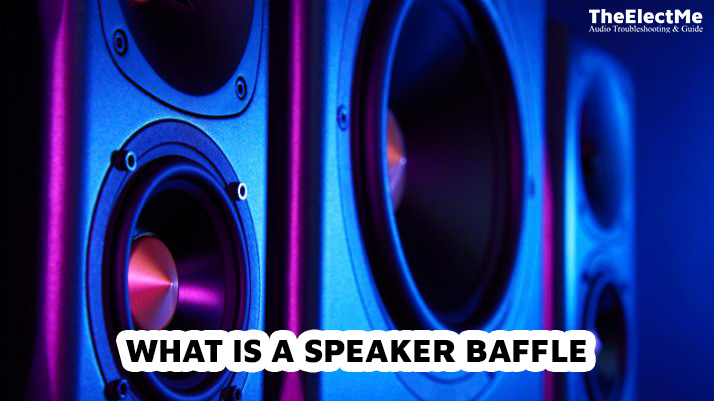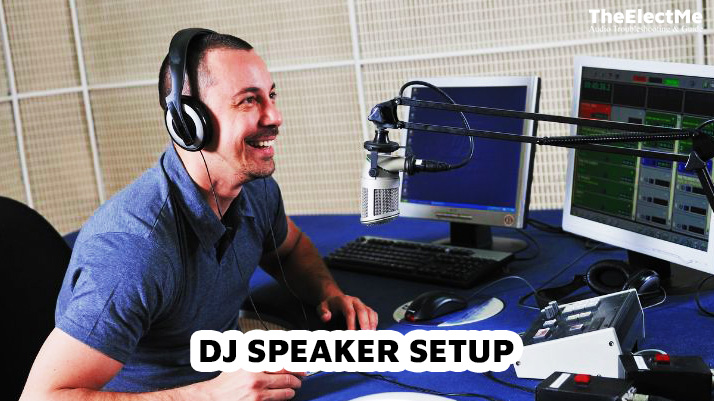What is a speaker baffle? A speaker baffle, also known as a speaker enclosure or cabinet, is essential in creating high-quality audio sound. The structure houses speaker drivers and enhances their performance by controlling sound waves.
Understanding speaker baffles is crucial for anyone in audio, whether a sound engineer, hobbyist, or music lover pursuing optimal quality and knowing how the baffle works can help you choose the right speakers and optimize their performance. It also helps in troubleshooting and resolving common sound issues.

In the vast world of audio equipment, the speaker baffle is one key to unlocking superior sound quality.
Let’s explore the world of speaker baffles.
What Is The Role Of A Speaker Baffle In Speaker Performance?
Speaker baffles are pivotal in how sound waves are managed and projected. They significantly affect how speakers emit sound, influencing the volume and audio quality.
Here are the main functions and roles of a speaker baffle in speaker design:
a) Speaker Baffles Affect Sound Waves
A speaker baffle acts as a barrier to prevent sound waves from the front and back of the speaker from colliding. This collision can cause phase cancellation, where specific frequencies cancel each other out, leading to muffled or distorted sound.
By separating the front and back sound waves, the baffle ensures that listeners only hear the intended audio output from the front of the speaker.
b) Speaker Baffle Manage Sound Waves
The baffle’s primary function is managing sound waves. It controls the direction of sound radiation, ensuring that it is projected forward toward the listener. Preventing undesirable effects like diffraction, where sound waves bend around the speaker and interfere with direct sound, is crucial.
c) Speaker Baffle impact Sound Quality
The baffle’s role in managing sound waves directly impacts the excellent quality. A well-designed baffle can minimize phase cancellation and diffraction, producing clear, high-fidelity sound. Conversely, a poorly designed baffle may result in a loss of specific frequencies, reducing overall sound quality.
d) Protect Speaker Components
Beyond their impact on sound quality, speaker baffles also serve a protective function. They shield the speaker components from potential damage as a physical barrier against dust, debris, and mechanical impact. Baffles also help maintain the structural integrity of the speaker by providing a secure mounting point.
Now, let’s delve into the different types of speaker baffles.

What Are The Different Types Of Speaker Baffles?
Speaker baffles come in various shapes, sizes, and materials, each with unique effects on sound quality. Here are some common types of speaker baffles:
a) Open Baffle Speakers
Open baffle speakers, or dipole speakers, have a flat panel or board holding the speaker driver. This design allows sound to radiate from both the front and back of the speaker. The result is a natural, spacious sound, often likened to a live performance.
b) Closed Baffle Speakers
Closed baffle speakers, or sealed or acoustic suspension speakers, have an enclosed design. They typically consist of a speaker mounted on a box-like enclosure. This design improves bass response and enhances speaker movement control, producing accurate sound reproduction.
c) Infinite Baffle Speakers
Infinite baffle speakers are a variation of the closed baffle design. They use a baffle larger than the wavelength of the lowest frequency they reproduce. This baffle separates front and rear sound waves, reducing phase cancellation and enhancing clarity.
These are the types of speaker baffles commonly used in speaker design. Each type has unique benefits; the choice depends on the desired sound quality and application. Sometimes the speaker’s sound quality is not good because the speaker sounds muffled. To know why your speaker sounds muffled click here.
Let’s explore the material on which the speaker baffle is made and how it affects proper performance.
What Are The Materials Used In Speaker Baffles, And How Do They Impact Sound Performance?
The design and material of a speaker baffle are critical factors in determining the speaker’s overall sound quality. They influence how sound is reproduced and dispersed and how resonance and vibration are managed.
Speaker baffles are typically made from rigid materials to resist vibration and provide a stable mount for the speaker. These materials include wood (especially MDF or medium-density fibreboard), plastic, and metal. Each material has its specific acoustic properties that can influence the sound quality.

Baffle Influence Sound Reproduction
The design of the baffle – its shape, size, and the material used – directly impacts how sound is reproduced. A wider baffle, for example, can improve bass response, while a circular or curved baffle can reduce diffraction and improve sound dispersion.
The material used affects speaker resonance. Denser materials minimize unwanted vibrations, resulting in a cleaner sound.
The baffle’s shape plays a crucial role in how sound is dispersed. Flat baffles can cause diffraction, where sound waves bend around the edges and interfere with the direct sound. This can result in an uneven field. Curved or rounded baffles help mitigate this issue by evenly dispersing sound waves, creating a balanced good field.
The Impact of Baffle Material on Resonance and Vibration
The material used for the baffle significantly affects the speaker’s resonance and vibration. Denser materials like MDF or metal tend to have lower resonance, which means they vibrate less at the frequencies produced by the speaker. This results in less coloration of the sound and a more accurate audio reproduction.
The design and material of the speaker baffle are not just aesthetic considerations. They profoundly impact the speaker’s performance and the listening experience. How to fix the blown-out speakers.
Final Thoughts – What Is A Speaker Baffle?
To conclude, a speaker baffle is essential in managing sound waves and protecting speaker components. A well-designed and constructed baffle can make all the difference in your listening experience.
Understanding the various types of speaker baffles and their impact on sound quality can help you decide when choosing a speaker.
Next time you shop for speakers, consider the baffle design and material to ensure you get the best sound possible. So, explore different speaker baffle types to find the perfect one for your audio needs.



